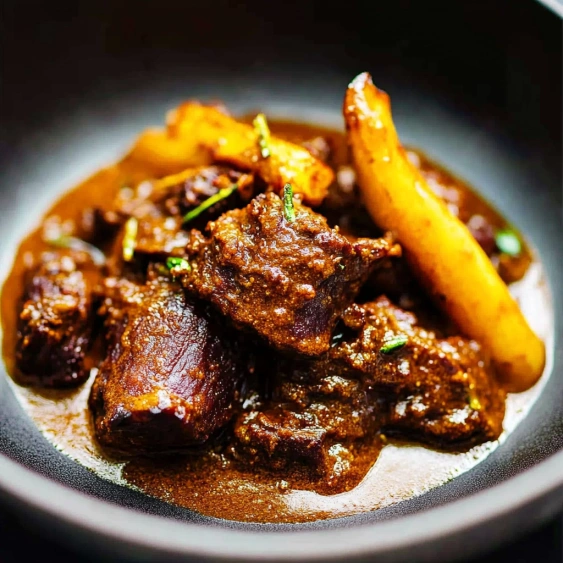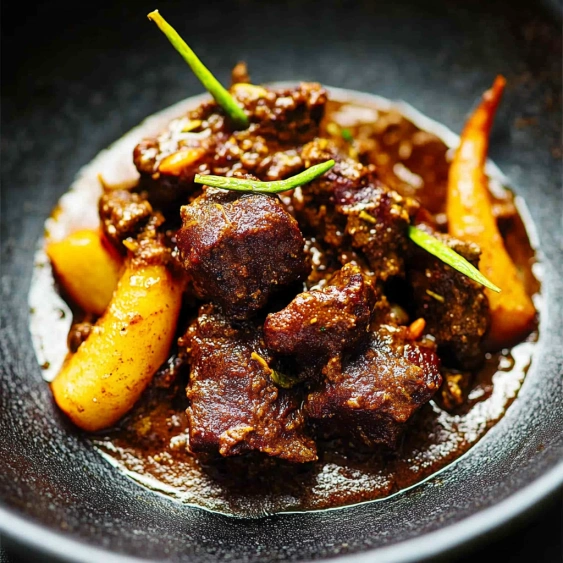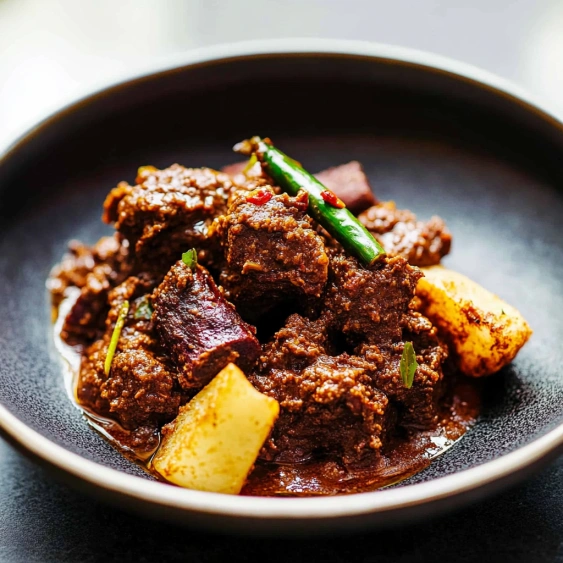 Pin it
Pin it
This aromatic beef rendang transforms humble short ribs into an intensely flavored masterpiece through slow cooking with coconut milk and a homemade spice paste. The end result offers meltingly tender meat with a concentrated, caramelized sauce that will transport you straight to Southeast Asia.
I first attempted rendang after returning from a trip to Malaysia where I became obsessed with this dish. After several attempts to recreate what I had experienced, this version finally captured that perfect balance of spicy, savory, and slightly sweet flavors.
Ingredients
- Boneless beef short ribs: These become meltingly tender when slow cooked and have enough fat to remain juicy
- Cinnamon stick: Adds warm undertones that balance the heat in the dish
- Cloves: Provide aromatic punctuation throughout the sauce
- Star anise: Contributes a licorice-like complexity essential for authentic flavor
- Cardamom pods: Offer citrusy floral notes that lighten the rich sauce
- Lemongrass: Brings bright citrus notes that cut through the richness
- Coconut milk: Creates the base for the sauce – use full-fat for best results
- Tamarind pulp: Provides essential sourness that balances the rich coconut
- Kaffir lime leaves: Add distinctive citrus aroma impossible to substitute
- Kerisik (toasted coconut): Thickens and enriches the sauce with nutty depth
- Palm sugar: Rounds out the flavors with caramel notes better than regular sugar
Spice Paste
- Shallots: Sweeter and more complex than regular onions
- Galangal: Similar to ginger but with piney citrus notes
- Garlic: Forms flavor foundation with shallots
- Ginger: Adds warmth and slight spiciness
- Dried chilies: Provide heat and earthy flavor – use more or less to taste
Step-by-Step Instructions
- Prepare the Spice Paste:
- Roughly chop all spice paste ingredients to help your food processor work more efficiently. Process until completely smooth, about 2 minutes, stopping occasionally to scrape down the sides. The paste should have no visible chunks for the best texture in the final dish.
- Bloom the Aromatics:
- Heat oil in a heavy-bottomed pot over medium heat until shimmering but not smoking. Add the spice paste along with cinnamon stick, cloves, star anise, and cardamom pods. Cook for 3 to 5 minutes, stirring constantly to prevent burning. You want the paste to darken slightly and become intensely fragrant as the oil extracts the flavors.
- Sear the Meat:
- Add beef cubes and pounded lemongrass to the aromatic oil. Stir continuously for 1 to 2 minutes until the meat is evenly coated with the spice mixture and begins to brown slightly on the edges. This step seals in juices and begins building flavor layers.
- Begin the Slow Simmer:
- Pour in coconut milk, tamarind juice, and water, stirring well to combine. Bring to a gentle simmer, then reduce heat to medium-low. Cook uncovered for about 60 minutes, stirring occasionally to prevent sticking. The liquid should maintain a gentle bubble, not a rapid boil.
- Add Final Flavoring Elements:
- Stir in the finely sliced kaffir lime leaves, kerisik, sugar, and a pinch of salt. The sauce should now be starting to reduce and coat the meat more thickly. These additions bring brightness and depth to the developing flavors.
- Slow Cook to Perfection:
- Reduce heat to lowest setting, cover the pot, and simmer for at least 60 to 90 minutes more until the meat is fork-tender and the sauce has reduced to a thick coating. Stir occasionally and add small amounts of water if it becomes too dry before the meat is tender. The final consistency should be almost dry with the sauce clinging to the meat.
 Pin it
Pin it
My absolute favorite moment is watching guests take their first bite of rendang. The complex layers of flavor always elicit a moment of surprised silence followed by enthusiastic appreciation. My Indonesian friend told me this version rivals his grandmother’s, which remains my proudest culinary compliment.
The Art of Patience
Rendang is fundamentally about patience. Unlike many Western stews that maintain a soupy consistency, this dish undergoes a transformation as liquid evaporates and flavors concentrate. The process cannot be rushed. What begins as meat simmering in liquid gradually becomes meat coated in an intensely flavored paste as water evaporates and coconut milk solids caramelize. This is why traditional rendang was a preservation method – the reduced moisture and concentrated spices acted as natural preservatives.
Regional Variations
Rendang originated in West Sumatra, Indonesia, among the Minangkabau people but has spread throughout Southeast Asia with each region adding its own twist. Malaysian rendang tends to be slightly sweeter, while Javanese versions often incorporate more coconut. In Singapore, you’ll find rendang with a thicker gravy, while in its homeland of Padang, the authentic version is quite dry. This recipe leans toward the traditional Padang style but with a slightly saucier finish to appeal to Western palates accustomed to gravies.
Kerisik: The Secret Ingredient
The toasted coconut paste called kerisik is what distinguishes exceptional rendang from merely good versions. To make it properly, toast unsweetened desiccated coconut in a dry pan until golden brown, stirring constantly to prevent burning. Then grind it into a paste using a mortar and pestle or food processor. This ingredient adds a nutty richness that thickens and enriches the sauce while also adding textural complexity. Store-bought versions exist, but making your own delivers dramatically better results with minimal extra effort.
Serving Traditions
While steamed rice is the classic accompaniment to rendang, Indonesians and Malaysians enjoy it with lemang (a sticky rice cooked in bamboo tubes), ketupat (rice cakes wrapped in palm leaves), or even crusty bread for soaking up the rich sauce. A simple cucumber sambal provides refreshing contrast to the rich meat. Rendang is traditionally served at room temperature rather than piping hot, allowing the complex flavors to be fully appreciated. At celebrations, it often appears alongside other dishes like sayur lodeh (vegetable curry) and various sambals.
 Pin it
Pin it
Frequently Asked Questions
- → What is kerisik and how do I make it?
Kerisik is toasted coconut that adds richness and texture to Beef Rendang. To make it, dry-toast freshly grated unsweetened coconut in a pan over medium heat until golden brown, stirring constantly. Once cooled, grind it into a paste using a food processor or mortar and pestle.
- → Can I make Beef Rendang in advance?
Yes, Beef Rendang actually tastes better the next day as the flavors have time to develop. Once cooled, store it in an airtight container in the refrigerator for up to 4 days. Reheat gently on the stove, adding a splash of water if needed.
- → What can I substitute for kaffir lime leaves?
If kaffir lime leaves aren't available, you can substitute with 1 teaspoon of lime zest plus 1/4 teaspoon of bay leaf per 2 leaves called for in the recipe. While not identical, this combination provides similar aromatic citrus notes.
- → What cut of beef works best for rendang?
Tough, collagen-rich cuts like beef short ribs, chuck, or brisket work best for rendang. These cuts become tender and flavorful during the long cooking process. Avoid lean cuts like sirloin or tenderloin as they'll become dry.
- → How spicy is traditional Beef Rendang?
Traditional Beef Rendang has a moderate heat level from the dried chilies. You can adjust the spiciness by changing the number of chilies or removing more seeds before blending. For a milder version, substitute some of the dried chilies with red bell peppers.
- → What side dishes pair well with Beef Rendang?
Beef Rendang pairs wonderfully with steamed jasmine rice, nasi lemak (coconut rice), or roti canai (Malaysian flatbread). For a complete meal, serve with simple vegetable sides like stir-fried water spinach (kangkung) or cucumber salad to balance the rich flavors.
